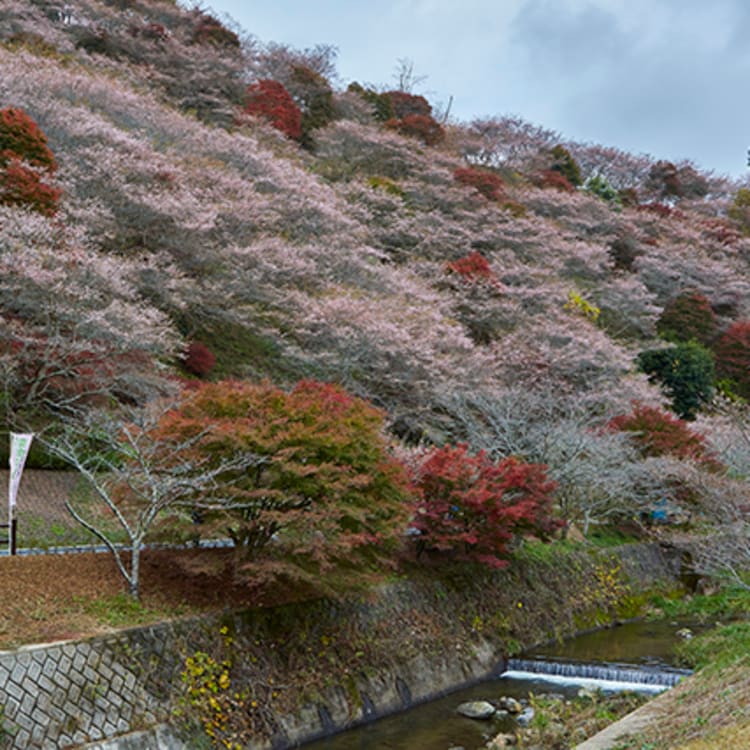
GUIDE Obara Shikizakura Festival by JNTO on 09 September 2018
If you’re lucky enough to be in Japan’s Chubu Region during November, Aichi Prefecture is a destination you shouldn’t miss. Located just a few hours away from Tokyo, the prefecture is home to one of Japan’s most fascinating autumn events — the Obara Shikizakura Festival.
The festival is named for Obara, a rural district located in the mountainous area north of Toyota City, and shikizakura, which is a rare type of cherry tree that blooms in both spring and fall. The area has well over 10,000 sakura trees – including the Maehora Shikizakura, a designated natural monument that is over 100 years old.
Obara district is also famous for its fall landscape, with most of them making the autumn leaf colour transition from lush tones of green to vibrant hues of red from late October, and Obara’s rare shikizakura cherry trees make the festival a visual spectacle for visitors – their pinkish-white, five-petaled blossoms create a magnificent colour contrast with the fiery landscape. The sakura flowers and maple leaves tend to be at their peak from mid to late November, depending on the year.

Where can you see the Obara Shikizakura Festival?
The Obara Shikizakura Festival is held every year at Fureai Park, Aichi Prefecture’s prime destination for viewing the flowering blossom trees and autumn foliage. At Fureai Park, you can experience the breathtaking view of the park’s 300 shikizakura trees along its serene walking paths. As part of the festival, there will be taiko drum performances, haiku competitions, food stalls, and other events throughout the park.
There are numerous spots in Obara where you can find the shikizakura, and there’s even a shikizakura walking and driving course (9.6km long) across Obara, taking in 6 parks (see this map in Japanese) that feature shikizakura. Two recommended places to see the blooms are Kawami (or Senmi) Shikizakura no Sato and Washi no Furusato (Obara Paper Museum).
Kawami Shikizakura no Sato has over 1,000 shikizakura trees dotted throughout the hilly area, accessible via steep trails (one of which leads you to a small shrine). There are also flatter and shorter paths along the river. With a few food stalls, it is generally much quieter and generally more scenic than Fureai Park as it features far more blossoms. Washi no Furusato is another site that’s worth visiting – while it has far fewer shikizakura, it does have an interesting washi paper museum.
The shikizakura festival is held throughout the entire month of November, though the peak bloom is from mid to late November.
What to eat in Obara and Aichi Prefecture?
During the festival, grab yourself a goheimochi – toasted mochi on a stick, dipped with sweet red-coloured hatcho miso – which is available at stands everywhere, and is popular in the mountain area of Toyota City.
While miso is used throughout Japan, Aichi Prefecture is famous for its hatcho miso, which is famous throughout the country for its reddish brown colour and rich and bold flavour that makes it the perfect base for sauces, soups, and broths. You can visit the Maruya Hatcho Miso factory and take a free tour to see how it’s made firsthand.
Numerous local specialties feature hatcho miso, including hitsumabushi (chopped red miso-flavoured eel over rice), miso katsu (fried breaded pork dipped with red miso sauce), and misonikomi udon (thick wheat flour noodles in red miso-flavoured broth).
Nagoya is an excellent destination to try various hatcho miso dishes. Some renowned restaurants include Houraiken (for hitsumabushi), Misokatsu Yabaton (miso katsu), and Yamamotoya (the originator of misonikomi udon).

How do you get to the Obara Shikizakura Festival?
The easiest way to get to Fureai Park is to take a 1-hour bus ride from Toyatashi Station to Obara Okusa bus stop, which is only a 5-minute uphill walk away from the park. Here’s a link to find more information on the bus schedule and fare to and from Fureai Park.
Date: 1 November – 30 November 2018 (peak bloom is mid to late November)
Time: 09:00 – 17:00
Entrance fee: Free
























































